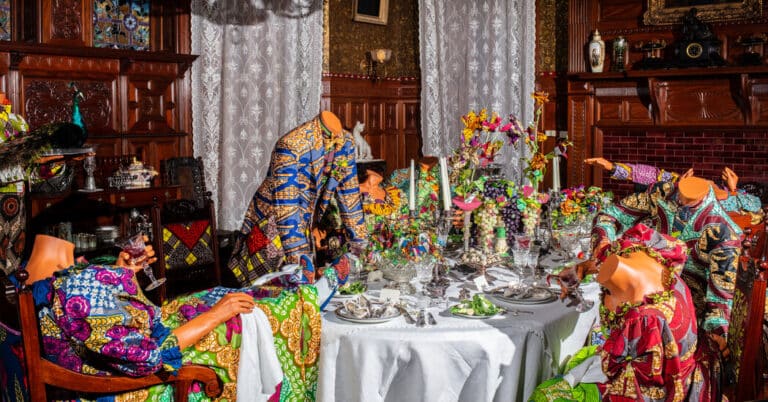Sumptuous gilded ornamentation still teems throughout the brick home of the Ballantine family of beer makers in Newark, built in 1885. But objects and artworks newly incorporated into the period rooms show how underappreciated strivers maneuvered in Newark society during the Ballantines’ heyday.
The Ballantine House, long used as an annex to the adjacent Newark Museum of Art on Washington Street, is reopening to the public Nov. 17, after a two-year, $12 million restoration — and rethink. The goal of the overhaul was “to wake it up and shake it up,” said Linda C. Harrison, the museum’s director since 2019. The building, she added, was “not forgotten but just not able to get the attention that it deserved.”
Amy Simon Hopwood, the museum’s associate curator of decorative arts, who helped spearhead the new installations, said that visitors are encouraged to wonder, “Who’s doing the work to keep the room glittering?”
In the entrance hall, alongside a towering wooden mantelpiece carved with the family’s “B” initial, paintings have been added that depict working-class Newark life. In an 1870s street scene, firefighters race to quench a blaze, in a carriage full of firefighting equipment steered by a Black driver named Lorenzo Dowd Trent. There are tableaus of Italian Americans celebrating a religious festival in the 1920s, and factory workers from the 1930s pouring molten metal. In an upstairs bedroom, a honey-colored Victorian bedstead has been updated with a red-and-white patchwork quilt, made in the 1930s for Dorothy O. Smith, New Jersey’s first Black female podiatrist.
Headless mannequins, which the British-Nigerian artist Yinka Shonibare created for the museum in 2009, are feasting at the dining room table, piled with punchbowls and candelabra. Ballantine family heirlooms, newly scattered around the house, show signs of servants’ grueling labor: dazzlingly polished silver vessels from Tiffany & Company, a crisply ironed pillowcase, a recipe book singed by a cooking pot and stained with grease.
An entire gallery has been devoted to the artist and historian Noelle Lorraine Williams’s installation, “Stay: The Black Women of 19th-Century Newark,” part of an ongoing series called “Black Power! 19th Century.”
Williams, a longtime Newark resident, has combed archives and online sources, including eBay, to research the Ballantine neighborhood’s unsung residents and visitors. She has assembled portraits and documentation of the acclaimed soprano Marie Selika Williams; the teacher Ellen King, whose family home was an Underground Railroad station; the businesswoman and music teacher Sara O’Fake Evans; and the church leader Hannah Mandeville, who had been born enslaved. There are images of the 20th-century activist Louise Epperson; Eloise Spellman, a seamstress and mother of 11 killed by police or National Guard forces in 1967; and Sakia Gunn, a lesbian teenager murdered in 2003 in a hate crime a few blocks from the museum. (This fall a nearby street was named in Gunn’s honor.)
Williams said that “the long history of Blacks in Newark” has been “often invisible.” The community was historically far larger, prosperous and accomplished than is commonly believed, “helping to build this city,” she added. Black women residents of the 19th century have gone particularly unnoticed, and few depictions of them had been known to exist. In “Stay,” she said, “All of the images are hot off the press. This history is ‘new’ to most folks.”
John Ballantine, a second-generation beer maker, and his wife Jeannette commissioned the building from the architect George Edward Harney, who worked for various plutocrats including the Roebling family of bridgebuilders. Many of the construction workers were immigrants from Italy and Germany. In the family’s 27 rooms, silks and velvets were draped along the windows, walls and furniture upholstery, and paneling and fireplaces were carved from a rainbow of wood types including mahogany and cherry. Tastemakers from Manhattan were brought in to add more eye-catchers; in the library’s window by Louis Comfort Tiffany’s team, a windblown blond maiden basks in rays from an opalescent sun.
After John Ballantine’s death in 1895, Jeannette remained in the house with the couple’s only surviving daughter, Alice Young, who raised her family there. (Four of John and Jeannette’s eight children had died young of disease, and in 1905, one of their three surviving sons, Robert Ballantine, died by suicide at the house,


